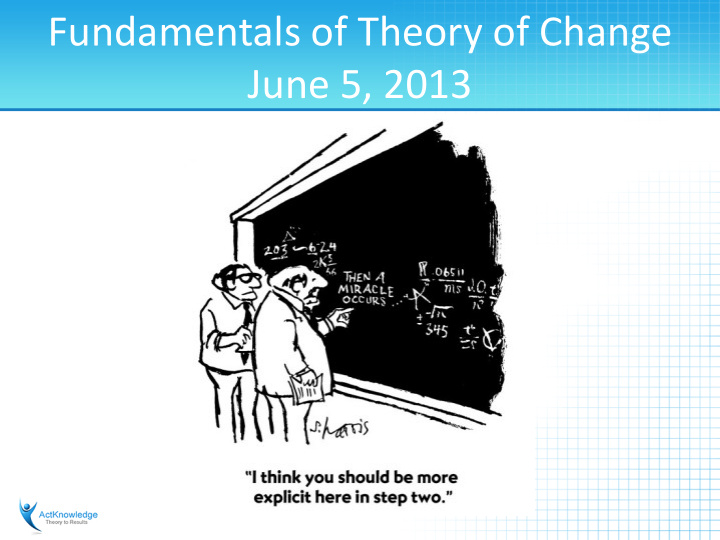



Fundamentals of Theory of Change June 5, 2013
What We Will Cover 1. Introduction 2. What is Theory of Change? 3. How it is used 4. The structure and components of a ToC 5. The visual language 6. Red flags 7. Questions
What is Theory of Change? A causal framework of how and why a change process will happen in a particular context. Rather than projecting outcomes from your activities, ToC reverses that process by focusing FIRST on WHAT OUTCOME you are seeking (your goal) – then thoroughly considering all preconditions necessary. Interventions and Activities are then based on your outcomes framework. (So you know why you are doing them!) A system with built-in Indicators so that you know you are on track over time. A process that makes assumptions explicit and identifies rationales for all preconditions and interventions (activities). Both a “process” and a “product.”
How ToC is used: As a roadmap of your Outcomes– how you get where you want to go. The basis of an agreement (buy-in) of all partners about what needs to happen and who does it. To demonstrate Collective Impact in a real way. Your framework for implementation (required interventions/actions). Your basis for monitoring and evaluation.
Recap ToC is a combination of collaboration, logic, and visual mapping.
Components of ToC 1. Outcomes and Preconditions, modeled in causal pathways 2. Interventions (activities), leading to the relevant Outcome(s) 3. Assumptions 4. Rationales 5. Indicators 6. Narrative
Theory of Change - Visual Language Accountability Ceiling
Ultimate Outcome vs. Long-Term Outcome Ultimate Outcome: Young People are “Successful in Life” ------------------------------------------------ Long-Term Outcome: Young people graduate from school with critical academic, social and life skills
PRECONDITIONS What HAS to change if the long- term goal is going to happen? This helps you avoid doing things that are good, but don’t get you where you want to go –
Preconditions: An Example Disaster Relief Meets Many Necessary the Needs of the Preconditions Affected Community Community has influence on how relief funds are distributed Community organizations have capacity to identify needs
Assumptions vs. Preconditions Assumptions Are beliefs about conditions that you think already exist and are not Problematic. And Are critical to the validity of the Theory. In the Process of developing a ToC, assumptions will emerge and this can be very valuable. It is important that the facilitator recognize and keep track of these. They must be aired and addressed. Are they correct? Should they be a Precondition?
Rationales Why that Precondition? • Explaining EVERY step of the way why the outcomes are needed and why they would lead to upper-level outcomes. Why that Intervention? • Why in a given context interventions (activities) done in a certain way are most likely to bring about the outcome. A developed rationale at these levels are crucial determinants of plausibility and feasibility of the theory.
Indicators Measurable Indicators of Success or EVIDENCE What does it look like if the outcome is met? Example: Outcome: Small Scale Farmers have access to capital. An Indicator might be: Proportion of Small Scale Farmers that obtain a business loan.
For Every Indicator: What ? (Access to Business Loans) For Whom ?(Small Scale Farmers in developing countries) How Many ?(50% of those that apply) How Good ? (affordable and effective) By When ? (within 12 months).
Interventions Actions or activities designed to achieve particular Outcomes. Differentiate from Outcomes. Interventions follow Outcomes (not vice versa). By identifying interventions as supporting a particular Outcome, it helps focus on what actually has to be done and who is best to do it. Interventions can be placed on any part of an Outcomes framework map.
Narrative(s) The plain language summary - short and compelling story that explains the map. Can have different versions to emphasize different points, level of detail, etc.
Red Flags There is no mandate or buy-in from key decision-maker(s) Don’t have the right people participating Outcomes are stated as actions or interventions not conditions Outcomes are compound statements Outcomes are too vaguely stated to make decisions Outcomes not in chronological order Backwards mapping doesn’t always work right away Not enough time and follow through given to the process Facilitation is not set up and run properly
How Do We Know If We Have a Good Theory? • Plausible • Feasible • Testable And, most of all, learn through your work and revise your theory with every lesson
Questions? ActKnowledge 365 Fifth Avenue, 6 th Floor New York, NY 10016 (212) 817-1906 dcolby@actknowledge.org ecollins@actknowledge.org _____________ www.actknowledge.org www.theoryofchange.org “Would you tell me, please, which way I ought to go from here?" "That depends a good deal on where you want to get to.” ― Lewis Carroll, Alice in Wonderland
Recommend
More recommend